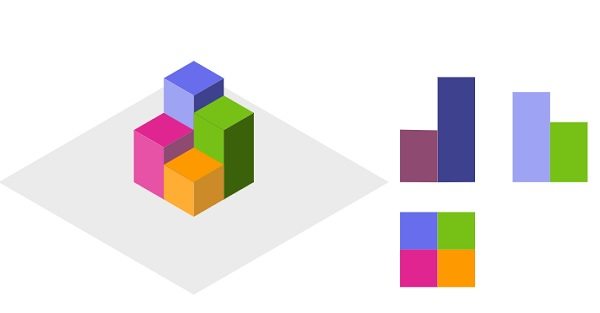
 Data Structure
Data Structure Networking
Networking RDBMS
RDBMS Operating System
Operating System Java
Java MS Excel
MS Excel iOS
iOS HTML
HTML CSS
CSS Android
Android Python
Python C Programming
C Programming C++
C++ C#
C# MongoDB
MongoDB MySQL
MySQL Javascript
Javascript PHP
PHP
- Selected Reading
- UPSC IAS Exams Notes
- Developer's Best Practices
- Questions and Answers
- Effective Resume Writing
- HR Interview Questions
- Computer Glossary
- Who is Who
Projection Area of 3D Shapes
Suppose there is a N x N grid, we place some 1 x 1 x 1 cubes that are axis-aligned with the x, y, and z. Here each value v = grid[i][j] is showing a tower of v cubes placed on top of grid cell (i, j). We view the projection of these cubes onto the xy, yz, and zx planes. Here, we are viewing the projection when looking at the cubes from the top, the front, and the side view. We have to find the total area of all three projections.
So, if the input is like [[1,2],[3,4]]

then the output will be 17.
To solve this, we will follow these steps −
- xy := 0, yz := 0, xz := 0
- for each row index r and row in grid, do
- yz := yz + maximum of row
- for each column index c and column col in row, do
- if grid[r][c] > 0 is non-zero, then
- xy := xy + 1
- if grid[r][c] > 0 is non-zero, then
- for each col in grid, do
- xz := xz + maximum of col
- return xy + yz + xz
Let us see the following implementation to get better understanding −
Example
class Solution(object): def projectionArea(self, grid): xy = 0 yz = 0 xz = 0 for r, row in enumerate(grid): yz += max(row) for c, col in enumerate(row): if grid[r][c] > 0: xy += 1 for col in zip(*grid): xz += max(col) return xy + yz + xz ob = Solution() print(ob.projectionArea([[1,2],[3,4]]))
Input
[[1,2],[3,4]]
Output
17

Advertisements
